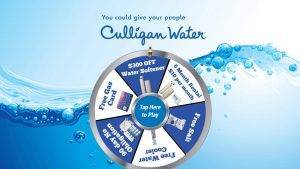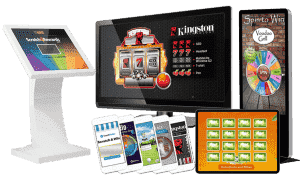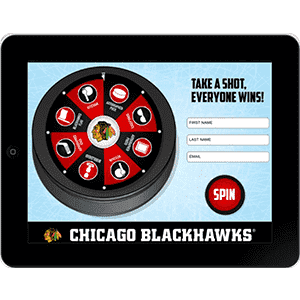Introduction to Digital Marketing Games for Promotions
Introduction to Digital Marketing Games for promotions
 In recent years, digital marketing games for promotions have emerged as a popular and effective way for brands to engage with customers and promote their products or services. Digital marketing games for promotions are a type of gamified marketing that uses games or game-like elements to create an immersive and engaging experience for users.
In recent years, digital marketing games for promotions have emerged as a popular and effective way for brands to engage with customers and promote their products or services. Digital marketing games for promotions are a type of gamified marketing that uses games or game-like elements to create an immersive and engaging experience for users.
What are digital marketing games?
Digital marketing games can take many different forms, including Instant Win games like a Virtual Prize Wheel, Scratch off Game. Digital Slot Machine and other interactive experiences. They are designed to be fun and engaging, while also promoting a brand, product, or service.
How do Promotional Games work?
Digital marketing games work by giving users a reason to interact with a brand. They may offer rewards or prizes or coupon for playing, or they may be designed to help users learn more about a product or service. By creating a game that is both fun and informative, brands can engage with their audience in a more meaningful way.
The benefits of using digital marketing games for Promotions
 There are several benefits to using digital marketing games as part of a brand’s overall marketing strategy. These benefits include:
There are several benefits to using digital marketing games as part of a brand’s overall marketing strategy. These benefits include:
Increased engagement: Digital marketing games are designed to be fun and engaging, which can help to increase user engagement with a brand.
Improved brand awareness: By incorporating branding elements into the game, brands can improve awareness and recognition of their products or services.
Enhanced customer loyalty: By offering rewards or prizes for playing, brands can encourage repeat engagement and improve customer loyalty.
Valuable user data: Digital marketing games can provide valuable insights into user behavior, preferences, and demographics, which can be used to inform future marketing efforts.
We will explore how to plan, design, develop, launch, and measure the success of a digital marketing game. We will also examine examples of successful digital marketing games and provide best practices for creating effective and engaging games.
Call now! 1-877-530-4499 for a fast quote and more detailed information.
Why Brand Gaming? We make this easy to do!
We will work directly with you to execute your promotion or application to be certain you are leveraging the full value of our systems. Secondly, we know that one size does not fit all and you don’t have the time to master every aspect of our technology. Most importantly Brand Gaming will work with you to build out your promotion. The execution does require good communication.
Planning Your Digital Marketing Game
To create an effective digital marketing game, it is essential to start with a solid plan. This chapter will explore the key steps involved in planning a digital marketing game, including identifying your target audience, setting goals and objectives, and choosing the right type of game for your brand.
Identifying Your Target Audience
 The first step in planning a digital marketing game is to identify your target audience. Understanding who your game is designed for will help you to create a game that is tailored to their interests and preferences.
The first step in planning a digital marketing game is to identify your target audience. Understanding who your game is designed for will help you to create a game that is tailored to their interests and preferences.
Start by creating buyer personas that describe your target audience in detail. This should include demographic information, as well as their motivations, behaviors, and pain points. Use this information to guide the design and development of your game.
Setting Goals and Objectives
Once you have identified your target audience, the next step is to set goals and objectives for your game. What do you hope to achieve through the game? Some common goals of digital marketing games include increasing brand awareness, generating leads, driving website traffic, or improving customer engagement.
It’s important to set specific, measurable goals that can be tracked and analyzed. This will help you to determine the success of your game and make improvements for future iterations.
Choosing the Right Type of Game for Your Brand
 There are many different types of digital marketing games to choose from, each with its own benefits and drawbacks. Some common types of games include:
There are many different types of digital marketing games to choose from, each with its own benefits and drawbacks. Some common types of games include:
Instant Win Contests: Contests can be a powerful way to generate buzz and excitement around your brand, while also incentivizing users to engage with your products or services.
When choosing the type of game to use, it’s important to consider your target audience and the goals you hope to achieve. The game should be designed to resonate with your target audience and help you achieve your marketing objectives.
Designing Your Digital Marketing Game
We will explore the key elements of game design that are essential for creating an effective and engaging digital marketing game. These elements include game mechanics, rules, visuals, and sound.
Game Mechanics
Game mechanics refer to the rules and systems that govern how your game is played. This includes controlling what you are giving away. Brand Gaming Offers Controlled Games. YOu set the inventory which creates the odds and elements that make your game fun and engaging.
When designing your game mechanics, it’s important to consider your target audience and the goals of your game. The mechanics should be designed to be simple and easy to understand, while also providing a level of challenge that keeps users engaged.
Rules
The rules of your game should be clear and easy to understand. Users should be able to quickly grasp how to play the game and what they need to do to succeed. Make sure that the rules are consistent throughout the game and that they are communicated effectively to the user.
Visuals
The visuals of your game are essential for creating an immersive and engaging experience for users. The graphics and animations should be visually appealing and consistent with your brand’s visual identity. Use colors, imagery, and typography that are consistent with your brand to reinforce brand recognition and awareness.
Sound
Sound is an often-overlooked element of game design, but it can have a significant impact on the user experience. Use sound effects and music that are consistent with the theme and tone of your game. Make sure that the sound is not too loud or distracting, and that users have the option to mute the sound if they prefer.
Testing and Iteration
Once you have designed your game, it’s important to test it thoroughly to identify any issues or areas for improvement. User testing can provide valuable feedback and insights that can be used to refine and improve your game.
Make sure to iterate on your game design based on user feedback and performance data. Continuously refine and improve your game to ensure that it meets your marketing objectives and engages your target audience effectively.
In the next chapter, we will explore the process of developing and launching your digital marketing game, including the technology and tools needed to bring your game to life.
Developing and Launching Your Digital Marketing Game
 The key steps involved in developing and launching your digital marketing game, including choosing the right technology, working with a development team, and promoting your game to your target audience.
The key steps involved in developing and launching your digital marketing game, including choosing the right technology, working with a development team, and promoting your game to your target audience.
When choosing your technology, it’s important to consider the user experience and make sure that your game is compatible with a wide range of devices and platforms. Make sure that your game is optimized for mobile devices, as more and more users are accessing content on their smartphones and tablets.
When working with a development team, it’s important to set clear expectations and communicate your goals and objectives effectively. Make sure that you have a clear project timeline, budget, and scope of work.
Promoting Your Game to Your Target Audience
Once your game is complete, it’s time to promote it to your target audience. Use your existing marketing channels, such as email marketing, social media, and paid advertising, to drive traffic to your game.
Consider using influencer marketing or other forms of collaboration to promote your game to a wider audience. You can also offer incentives or prizes to users who share your game on social media or refer their friends to play.
Measuring and Analyzing Results
Finally, it’s important to measure and analyze the results of your game to determine its effectiveness and identify areas for improvement. Use analytics tools to track user engagement, conversions, and other key performance indicators.
Make sure to use the insights you gain to continuously improve your game and make it more effective at achieving your marketing goals.
In the next chapter, we will explore some best practices for using digital marketing games effectively, including tips for creating a strong user experience and engaging your target audience.
Best Practices for Using Digital Marketing Games
We will explore some best practices for using digital marketing games effectively, including tips for creating a strong user experience and engaging your target audience.
Keep it Simple
When designing your game, it’s important to keep it simple and easy to understand. Users should be able to quickly grasp how to play the game and what they need to do to succeed. Make sure that the rules are consistent throughout the game and that they are communicated effectively to the user.
Focus on User Experience
The user experience should be at the forefront of your game design. Use a user-centered design approach to ensure that your game is easy to navigate, visually appealing, and enjoyable to play. Make sure that the game mechanics are intuitive and that the user can easily understand how to progress through the game.
Offer Incentives
To encourage users to engage with your game, offer incentives such as prizes, discounts, or other rewards. These incentives can motivate users to share your game with their friends and social media followers, helping to spread awareness of your brand.
Use Social Media
Social media is a powerful tool for promoting your digital marketing game and engaging your target audience. Use your social media channels to share updates and information about your game, as well as to encourage users to share the game with their followers.
Track Performance
Use analytics tools to track user engagement, conversions, and other key performance indicators. Use this data to continuously improve your game and make it more effective at achieving your marketing goals.
Keep it Relevant
Make sure that your game is relevant to your brand and your target audience. Choose a theme and game mechanics that are consistent with your brand’s messaging and identity, and that will appeal to your target audience.
Be Creative
Finally, don’t be afraid to get creative with your game design. Use innovative game mechanics, unique visuals, and engaging sound effects to make your game stand out from the competition.
By following these best practices, you can create an effective and engaging digital marketing game that helps to promote your brand and engage your target audience.
Developing a Compelling Game Concept
One of the biggest challenges in creating a digital marketing game is developing a compelling game concept that will engage your target audience. To overcome this challenge, it’s important to conduct research on your target audience and their preferences, as well as to brainstorm creative game ideas that align with your brand messaging and identity.
Balancing Fun and Marketing Objectives
Another challenge in creating a digital marketing game is balancing the fun and engaging aspects of the game with your marketing objectives. To overcome this challenge, it’s important to identify your marketing goals and ensure that your game mechanics and incentives align with these objectives. It’s also important to test the game with your target audience to ensure that it is both fun and effective at achieving your marketing goals.
User Engagement
Engaging users and promoting the game can also present a challenge, especially if your target audience is not familiar with your brand or the game concept. To overcome this challenge, it’s important to invest in marketing and promotion strategies that will help to increase awareness of the promotional game and encourage users to participate. It’s also important to incentivize users to share the game with their friends and social media followers.
By identifying these challenges and developing strategies to overcome them, brands can create effective and engaging digital marketing games that help to achieve their marketing goals and engage their target audience.
Best Practices for Digital Marketing Games
 We will offer some best practices for creating successful digital marketing games that engage your target audience and achieve your marketing goals.
We will offer some best practices for creating successful digital marketing games that engage your target audience and achieve your marketing goals.
Identify Your Target Audience
The first step in creating a successful digital marketing game is to identify your target audience. Conduct market research to understand your audience’s preferences and interests, and develop a game concept that will appeal to them.
Align Game Mechanics with Marketing Objectives
Your game mechanics should align with your marketing objectives. Determine what actions or behaviors you want your target audience to take, and design the game mechanics to encourage those behaviors.
Create an Engaging User Experience
Creating an engaging user experience is crucial to the
. Incorporate elements such as unique visuals, sound effects, and intuitive controls to make the game fun and easy to play.
Incorporate Social Sharing Features
Social sharing features can help to increase the reach of your game and encourage user engagement. Incorporate features such as social media integration and referral incentives to encourage users to share the game with their friends and followers.
Test and Iterate
Testing and iterating your game is essential to its success. Conduct user testing to identify areas for improvement and make changes to the game based on user feedback. This will help to ensure that your game is engaging and effective at achieving your marketing goals.
Promote the Marketing Game
Promoting your game is key to its success. Utilize a variety of marketing channels, such as social media, email marketing, and paid advertising, to promote the game to your target audience.
Measure Results
Measuring the results of your game is important to determine its effectiveness at achieving your marketing goals. Use metrics such as engagement, retention, and conversion rates to evaluate the success of the game, and make adjustments as necessary.
By following these best practices, you can create an effective and engaging digital marketing game that helps to achieve your marketing goals and engage your target audience.
Future of Digital Marketing Games
The future of digital marketing games for promotions and how they are likely to evolve in the coming years.
Increased Personalization
As technology continues to advance, digital marketing games are likely to become increasingly personalized. By leveraging data and artificial intelligence, games can be customized to the individual preferences and interests of each player, resulting in a more engaging and personalized experience.
Gamification of eCommerce
 As eCommerce continues to grow, there is a growing trend of gamifying the shopping experience. By incorporating game elements such as points, badges, and leaderboards, eCommerce sites can make the shopping experience more engaging and enjoyable for customers, while also increasing sales and customer loyalty.
As eCommerce continues to grow, there is a growing trend of gamifying the shopping experience. By incorporating game elements such as points, badges, and leaderboards, eCommerce sites can make the shopping experience more engaging and enjoyable for customers, while also increasing sales and customer loyalty.
Integration with Social Media
Social media has become an important marketing channel for many brands, and digital marketing games are likely to become increasingly integrated with social media. This can help to increase the reach of the game, encourage social sharing, and drive engagement.
Multi-Channel Distribution
As consumers increasingly use multiple devices and channels to access digital content, digital marketing games are likely to be distributed across a range of channels, including mobile apps, social media, and eCommerce sites. This can help to reach a wider audience and increase engagement.
Integration with Virtual Reality
Virtual reality (VR) is a technology that creates a completely immersive digital experience. As VR technology becomes more advanced and accessible, it is likely to be integrated into digital marketing games. This will allow for a more immersive and engaging game experience, which can help to increase engagement and drive sales.
These are just a few examples of how digital marketing games for promotions are likely to evolve in the coming years. By staying up-to-date with the latest trends and technologies, brands can create innovative and engaging digital marketing games that effectively promote their products or services and increase brand loyalty and awareness.

